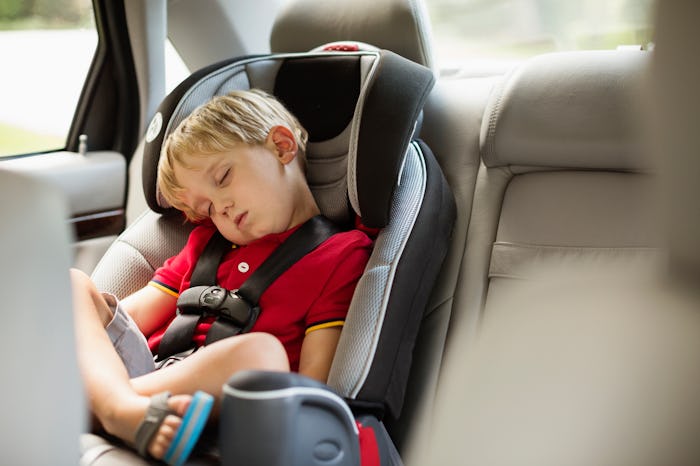The car seat slump

Are Car Seat Head Straps Safe?
Experts urge parents to steer clear.
You realize the car ride has gotten quiet all of a sudden. You look in the rearview mirror and see your chubby-cheeked toddler has dozed off, only to wince as their head flops forward. Their poor little neck just can’t be comfortable like that, right? Car seat head straps — a thin, padded piece of fabric that clips loosely around the top of the car seat, at about forehead level — are designed to catch your little one’s head when it begins to fall forward during a snooze. But are car seat head straps safe? Child safety experts are ready for these third-party products to go away already.
Are car seat head straps safe?
Probably not.
You can buy a head strap for your kid’s car seat on Amazon, Temu, SHEIN, Etsy, and other websites. They range in price from a few dollars a piece up to nearly $40, depending on how elaborate the design is.
While parents might do just about anything to help their kids sleep better and more comfortably, the car seat slump is one thing we just can’t prevent. And while car seat head straps seem like a harmless little gizmo, it’s safer to just let your kid’s napping noggin fall where it may.
“Sometimes companies may create products that seemingly meet a need, but we will never recommend something that the car seat manufacturer doesn’t recommend for use on their seat,” says Cass Herring, CPS, director of child occupant protection at Safe Kids Worldwide. “We always defer to the manufacturer’s instructions for use when we’re looking at car seats. These products don’t have specific regulations for them.”
Car seats are strictly regulated and undergo extensive crash testing, Herring explains, including how a child’s head is expected to move in an accident. This means that using your child’s car seat exactly as directed by the manufacturer — i.e. without adding a head strap — is the only way to ensure the seat actually lives up to its crash testing claims.
When it comes to car seats, you should never add products onto the seat that didn’t come with it, according to Nancy Cowles, executive director of Kids In Danger. “No extra padding, no special boosters that go behind the child or anything. Certainly no extra straps. If these products helped with the issue they’re trying to address and were safe, they’d probably start coming with car seats.”
Using a head strap can even lead to more severe injuries in the event of a crash, Cowles says, including “internal decapitation” — when the skull breaks away from the spine, but the surrounding tissues and ligaments remain intact. “Car seats are tested for crashes for children who are properly strapped in to survive the incidents, and that little thing can actually change that and cause really severe injuries that otherwise wouldn’t have happened,” she says.
Is it OK for my toddler to sleep with their head down in the car seat?
While it looks mighty uncomfortable, it’s safer for your child to slump in their sleep than to install a head strap. Parents may worry about positional asphyxia, which happens when a person’s posture blocks their airway and prevents them from breathing. This shouldn’t be an issue for toddlers, Cowles says.
“The children for whom that is a big concern are babies under a year old, and especially those under 5 months or so, but they’re going to be in a rear-facing car seat where their head is not going to do that. For older children, there’s no danger.”
If you see a product like a car seat head strap and want to know if it’s safe to use, Herring recommends reaching out to child passenger safety technicians in your area. They are trained and certified by Safe Kids Worldwide to check that your car seat is installed correctly and teach parents how to use them, and they can answer any questions you might have about adding third-party products to your child’s seat. That said, the safest thing to do is just steer clear of any accessories not sold by your car seat manufacturer.
Experts:
Nancy Cowles, executive director of Kids In Danger
Cass Herring, CPS, director of child occupant protection at Safe Kids Worldwide